The Multi-channel sales framework is an online-trade solution for Comarch ERP Enterprise system. It makes it possible to manage multiple external systems (web shops, applications, sales platforms) using adapters.
The framework provides applications that e.g. enable the user to:
- manage connection with sales channels
- assign customer templates in order to automatically fill in certain data on the customer form upon data import
- export data (e.g. items, media, price lists, available item quantities, item characteristics) to sales channels using batch applications
- import data (e.g. customers, sales orders) to the system using batch applications
- delete unused data (e.g. by reorganizing reservations)
- reserve items for sales channels or Comarch ERP Enterprise system
- preview and verify the data of sales channel partners, items, orders
- support B2B and B2C customers
Definition of terms
Adapter – a module that allows the multi-channel sales framework to cooperate with an external system (e.g. a web shop or call center) and is responsible for data conversion. One adapter can connect to multiple instances of an external system. Available adapters include:
- Amazon
- Cloud
- Comarch ERP Webshop
- Comarch Retail POS
- OXID eSales
- Magento
- IBUS
- Shopware
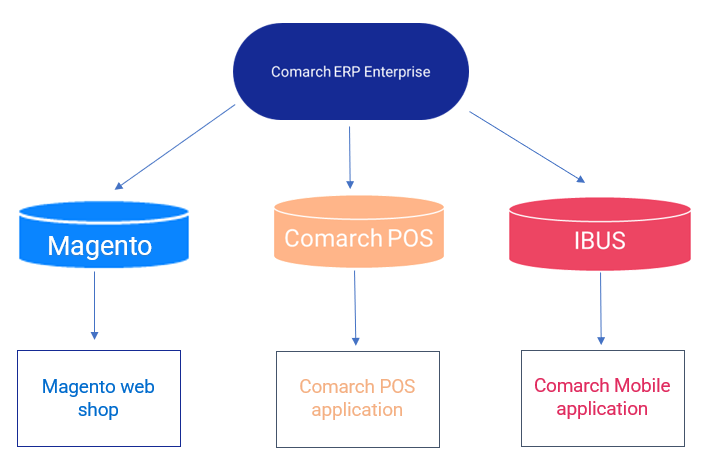
Batch applications – applications allowing data synchronization between Comarch ERP Enterprise and external systems. Batch applications take the form of dialog windows that close when a given application is launched, allowing the user to continue using the system while data is being synchronized. Batch application activity can be traced with the use of the Batch jobs application.
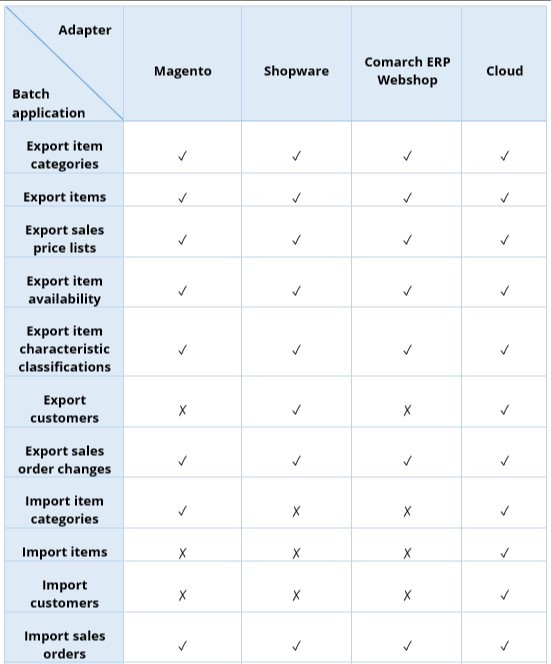
B2B/B2C – customer types supported by the system:
- B2B (business-to-business) – organization. It allows the user to e.g. process orders placed by employees on behalf of their organizations.
- B2C (business-to-customer) – a natural person, not affiliated with any organization, including unregistered customers
Sales channel – depending on the context, the term might have one of the following meanings:
- An external system in which items are sold (e.g. a web shop, call center)
- The system’s business entity (created in the Sales channels application) that enables connection with an external system
PIM (Product Information Management) media – they make it possible to enrich item information with media (e.g. images, audio files, links), product associations (e.g. variant items, substitutes), or characteristics (e.g. size, color) for all or selected sales channels
Sales channel hierarchy
The Sales channels application allows the creation of master channels, sub channels, and single stores. In a channel hierarchy, sub channels inherit some settings of the master channel. This refers to:
- Customer type
- Item template
- Item characteristic classifications for variant items
- Settings from the Warehouse inventory management tab (except for the fields Delivery warehouse selection method and Delivery warehouse – if the latter is unlocked by a relevant option in the former)
- PIM – Item characteristic groups tab settings
- PIM – Item characteristic settings tab settings
- Other fields tab settings
Below is an overview of the availability of batch applications for different types of sales channels:
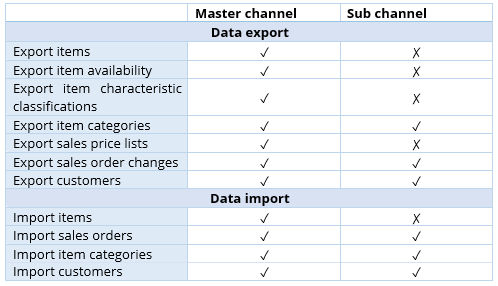
✓ – execution of the batch is unrestricted
✗ – execution of the batch is restricted
Standard export and import sequence
In order for synchronization with an external system to be performed correctly, the recommended sequence of exporting sales channel elements must be followed.

To manage an order placed in an external store, the user must perform import operations in the standard recommended sequence.
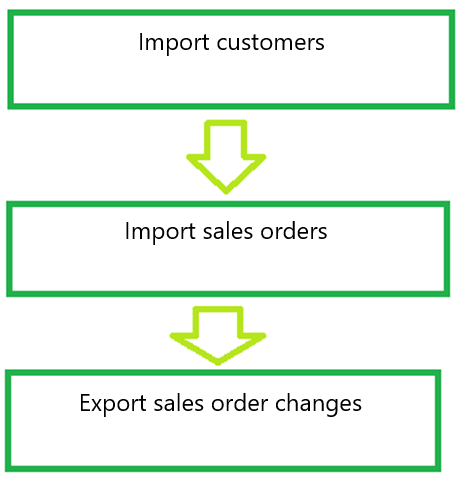
Batch applications – Errors, warnings, information
Batch application activity can be tracked in the Batch jobs application. By default, the application lists batch applications launched by the currently logged-in user. After selecting a given application on the list and clicking the [Message logs] button, the system opens the list of messages related to a given batch job, including all messages, errors, and warnings concerning data synchronization. It allows tracking potential errors preventing correct synchronization.
Calculation of sales channel item availability
For an item to be available for sale in an external system, it is necessary to calculate its available quantity and upload it to the relevant external system using the Export item availability application.
Comarch ERP Enterprise system includes applications influencing the calculation of item availability:
- Sales channel reservations – it allows reserving items for a sales channel
- ERP reserve inventory levels – it allows reserving items for the ERP system, at the same time reducing the available item quantity in sales channels
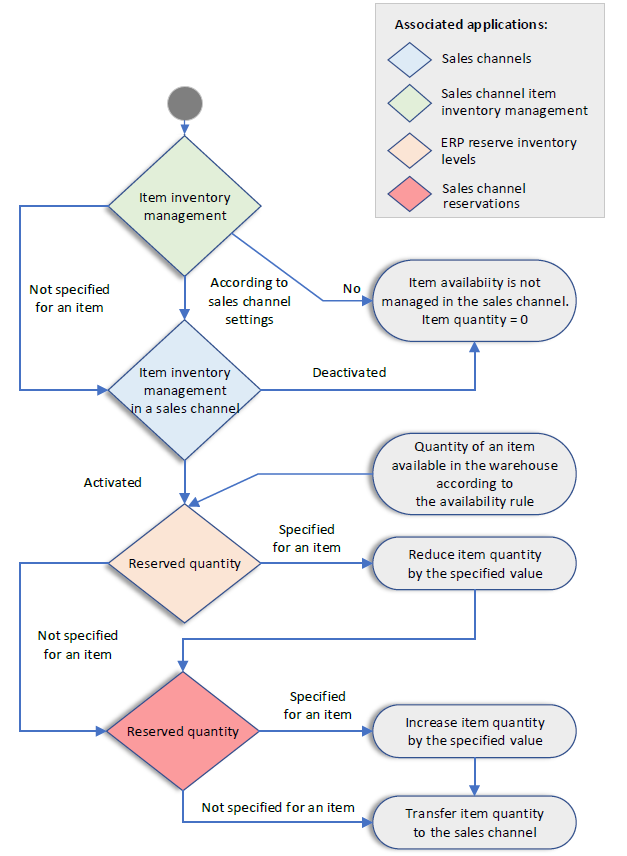
Price calculations
In Comarch ERP Enterprise system, prices are assigned to individual items in the Sales price lists application. After exporting a price list assigned to an appropriate sales channel, in an external system the prices are shown next to the items to which they have been assigned. Each subsequent export of the price list updates prices in the sales channel for selected or all items.
For sales channels supporting both B2B and B2C processes, it is possible to add a separate price list for each customer type.
By default, any price and discount entered in a sales channel price list are recalculated for an item when transferring the price list to the sales channel.
Also, the Multi-channel sales framework makes it possible to create personalized price lists for customer groups.
Basic configuration of a sales channel
In order to properly configure a sales channel, it is necessary to:
1. Make sure that the Multi-channel sales function in the Customizing application has the Active parameter selected and that all required fields are filled in for the General function (belonging to the Multi-channel sales grouping).
2. Make sure that an appropriate adapter has been installed and has the Active parameter selected in the Customizing application
3. Open the Sales channels application to configure connection with the external system. The description of the application and its settings may be found in the Sales channels article. Depending on the adapter selected in the Sales channels application header, a different adapter tab will be available, allowing the user to configure connection with an appropriate online shop. Settings available on the tabs are described in articles concerning individual adapter extensions to the Sales channels application.
4. Perform the first export operation (e.g. Export item categories) in order to synchronize data between Comarch ERP Enterprise system and the external system. In the case of the Comarch ERP Webshop adapter, it is also necessary to run the Comarch Webshop activate synchronization application. The first running of the batch applications creates a sales channel between Comarch ERP Enterprise and a given external system. The channel allows transferring data between the systems (e.g. item or pricing data).
The Multi-channel sales framework provides applications allowing the additional configuration of sales channel connection; for instance, the Sales channel partners application allows assigning Comarch ERP Enterprise system partners to a given sales channel, which makes it possible to export them to an external system. The description of individual applications and their capabilities may be found in the Multi-channel sales category.
Depending on the adapter, additional settings may be required in dedicated applications. For instance, the Shopware adapter requires the assignment of units (payment forms, countries) in the Shopware assignments application. Settings required by particular adapters have been described in relevant adapter-related articles.

